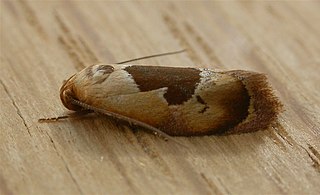
Hoplomorpha camelaea is a moth in the family Oecophoridae first described by Edward Meyrick in 1888. It is found in Australia, where it has been recorded from Victoria, Queensland, New South Wales and the Australian Capital Territory.

Grammodes stolida, the geometrician, is a moth of the family Erebidae. The species was first described by Johan Christian Fabricius in 1775. It is found in Africa, southern Europe, most of Asia and Australia. It migrates to central and northern Europe as far north as England, Denmark and Finland.

Trichoptilus ceramodes is a moth of the family Pterophoridae that is found in Australia, including New South Wales and South Australia.
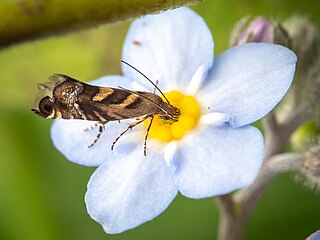
Glyphipterix tungella is a species of sedge moth in the genus Glyphipterix. It is endemic to New Zealand and is found throughout the country. Larvae mine the leaves of small sedges. Adults of this species are day flying and inhabit sheltered scrub or grassy areas and forest clearings.
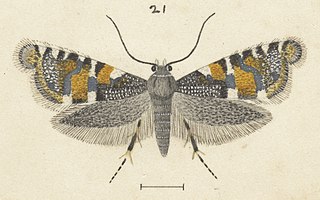
Glyphipterix euastera is a species of sedge moth in the genus Glyphipterix. It is endemic to New Zealand. This species is classified as "At Risk, Naturally Uncommon" by the Department of Conservation.
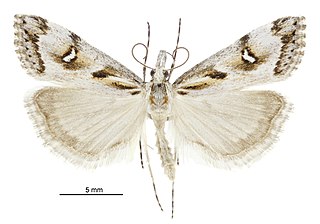
Gadira leucophthalma, the beaked moss moth, is a moth in the family Crambidae. It is endemic to New Zealand. It is found in the south eastern side of the South Island down to Banks Peninsula. G. leucophthalma inhabits the foredunes of coastal areas. The larval host is unknown but it has been hypothesised that the larvae feed on moss. The adult moths are day flying although some specimens have been trapped at night via light traps. Adults are commonly on the wing from March to April. This species has been classified as Nationally Vulnerable by the Department of Conservation.

Pyrgotis plinthoglypta is a species of moth of the family Tortricidae. It is endemic to New Zealand and is found throughout the whole country. The preferred habitat of this species is native forest. The larvae of this species feeds on rimu leaves from under a silken web. It pupates in loose cocoons amongst rimu foliage. Adults are on the wing from October to May and are night flying. They are attracted to light and can be collected by beating their host tree. The adult insect resembles a small dried fragment of rimu foliage when at rest.
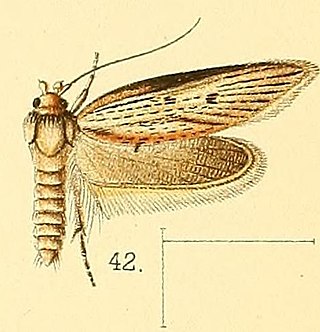
Procometis acutipennis is a moth of the family Autostichidae. It is known from the Gambia and Congo.
Habrona marmorata is a moth in the family Drepanidae. It is widely distributed in Papua and Papua New Guinea.
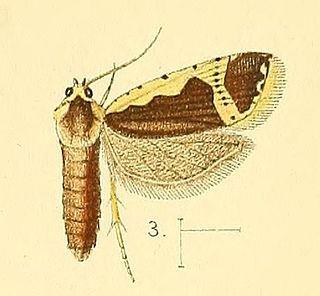
Panegyra flavicostana is a species of moth of the family Tortricidae. It is found in Cameroon, Nigeria and Gambia.
Catacometes hemiscia is a moth in the family Oecophoridae. It was described by Edward Meyrick in 1883. It is found in Australia, where it has been recorded from New South Wales.
Hoplomorpha epicosma is a moth in the family Oecophoridae. It was described by Alfred Jefferis Turner in 1916. It is found in Australia, where it has been recorded from Queensland.

Sanguinograptis albardana is a species of moth of the family Tortricidae. It is found in the Republic of Congo, the Democratic Republic of Congo, Equatorial Guinea, Guinea and Gambia.
Spatalistis aglaoxantha is a species of moth of the family Tortricidae. It is found in China.
Cathegesis psoricopterella is a moth in the family Gelechiidae. It was described by Thomas de Grey, 6th Baron Walsingham, in 1892. It is found on the West Indies.
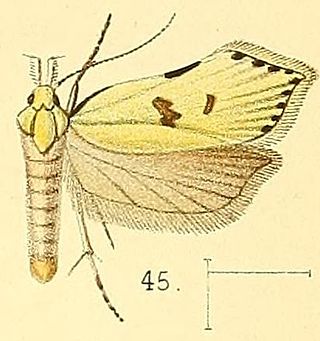
Dichomeris fracticostella is a moth in the family Gelechiidae. It was described by Thomas de Grey, 6th Baron Walsingham, in 1891. It is found in Ghana and Gambia.

Aspades hutchinsonella is a species of moth in the family Gelechiidae. It was described by Thomas de Grey, 6th Baron Walsingham, in 1891. It is found in Namibia, South Africa and Zimbabwe.
Idiophantis carpotoma is a moth of the family Gelechiidae. It was described by Edward Meyrick in 1916. It is found in southern India.
Isophrictis canicostella is a moth of the family Gelechiidae. It was described by Thomas de Grey, 6th Baron Walsingham, in 1888. It is found in North America, where it has been recorded from California and Colorado.
Lichenaula undulatella is a moth in the family Xyloryctidae. It was described by Francis Walker in 1864. It is found in Australia, where it has been recorded from New South Wales, Queensland and Western Australia.












